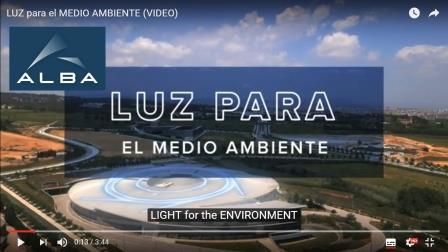
11/01/2017
ALBA Synchrotron Is Also a Tool for the Environment
ALBA Synchrotron Is Also a Tool for the Environment
Environment, health, food, cultural heritage ... ALBA synchrotron's users coming from universities and research centres explain in short videos how they have taken advantage of the synchrotron light and how it can benefit for their research.
The fourth of these videos posted on line just before Christmas is focused on environmental issues. Jordi Llorca, professor at the Universitat Politècnica de Catalunya (UPC), explains how the study, design and production of new catalysts can have a positive impact on environment. In that case, Jordi Llorca and his team have used the ALBA synchrotron CIRCE beamline, a variable polarization soft X-ray beamline dedicated to advanced photoemission experiments.
Thanks to CIRCE, these researchers have successfully analyzed the surfaces and the mechanisms of action of catalyst nanoparticles in conditions very close to actual conditions of use. These results allow the design of new catalysts, especially in two domains of special interest for Jordi Llorca’s team: catalysts to produce hydrogen and catalysts to oxidize the carbon soot emitted by diesel engines.
Please follow the ALBA’s Youtube channel to watch the complete series of these outreach videos. They are filmed in Spanish and Catalan, although subtitles are available in English, Catalan and Spanish using the Settings button and in many more languages with the Auto-translate option.
The fourth of these videos posted on line just before Christmas is focused on environmental issues. Jordi Llorca, professor at the Universitat Politècnica de Catalunya (UPC), explains how the study, design and production of new catalysts can have a positive impact on environment. In that case, Jordi Llorca and his team have used the ALBA synchrotron CIRCE beamline, a variable polarization soft X-ray beamline dedicated to advanced photoemission experiments.
Thanks to CIRCE, these researchers have successfully analyzed the surfaces and the mechanisms of action of catalyst nanoparticles in conditions very close to actual conditions of use. These results allow the design of new catalysts, especially in two domains of special interest for Jordi Llorca’s team: catalysts to produce hydrogen and catalysts to oxidize the carbon soot emitted by diesel engines.
Please follow the ALBA’s Youtube channel to watch the complete series of these outreach videos. They are filmed in Spanish and Catalan, although subtitles are available in English, Catalan and Spanish using the Settings button and in many more languages with the Auto-translate option.
More news
23/06/2016
Distributed Polygeneration: Barcelona Synchrotron Park Shares Its Experience
17/06/2016
Barcelona Synchrotron Park Sponsors the Fifth Ideas Generation Program
10/06/2016
The Nanoworld Is Designed and Observed In and Nearby Barcelona Synchrotron Park
02/06/2016
Mediterranean Corridor: an important infrastructure for Barcelona Synchrotron Park
26/05/2016
UAB University Makes Distance Wireless Charging a Reality
19/05/2016
HP Enters the 3D Printing Market









